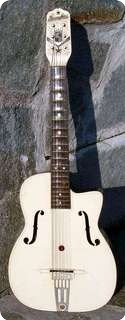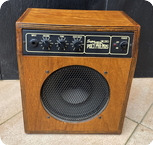Maccaferri Selmer / G30 Decorated / 1953 / White / Guitar
1950's SELMER - MACCAFERRI G30 "Decorated" model with hard case. code AC795
https://www.youtube.com/watch?v=cuB2hprvfdc
https://www.youtube.com/watch?v=eXH7EOqBnxo
http://orgs.usd.edu/nmm/PluckedStrings/Guitars/Maccaferri/10458/G40Guitar.html
This 1950's Maccaferri G30 "Decorated" is one of the most unique vintage guitars on the planet! Favored by aficionados like Jack White and Dave Grohl, these plastic novelty guitars have a soul and tone all to themselves. Designed by Mario Maccaferri, and made by the French American Reeds Manufacturing Company of Mount Vernon, New York in the 1950's.The fan bracing of the top differed from most wood archtops of the period, which either had X-bracing or parallel bars. While his Islander Ukuleles were made to appeal to professionals, amateurs, and children alike, Maccaferri’s Styron guitars were intended to be serious musical instruments and a legitimate alternative to the wood guitar, which is sensitive to changes humidity, unlike the plastic instrument. Maccaferri struggled for many years against the perception that his guitars were merely “toys” due to the material from which they were made.Top of the range ' Plastic' guitar made by Maccaferri in the 1950's. Totally unique design and concept from the gypsy style Django Rheinhardt models they were known for. A hell of a lot of research and tooling cash went into this idea and whilst very different in concept, it sadly didn't take off. This is definately not a toy !
The plastic guitar
Like the plastic clothespin before it, however, the plastic ukulele was merely a stepping stone to Maccaferri’s higher ambition of making a plastic guitar. Let’s face it, ukes hardly represent a great sonic challenge, but making a guitar out of Dow Styron? That’s something else altogether!The Maccaferri plastic guitar debuted in the Spring of 1953. The introduction was extensively covered by The Music Trades in May of ’53, which reported a press luncheon thrown by Dow Chemical for Mario Maccaferri at the Waldorf-Astoria hotel in New York on April 29, 1953.Described in glowing terms — lunch must have been great — Maccaferri introduced two guitars and emphasized the resources and cost of developing his new guitars. Indeed, Amos Ruddock of Dow’s plastic merchandising department indicated that the project took two years of testing various formulations of Styron and another Dow plastic called Ethocel and that tooling up cost around $350,000.The Music Trades quoted Maccaferri’s speech at length. While referring to a painting of legendary violinmaker Antonio Stradivarius working at his bench with a few simple tools, Maccaferri remarked, “A like painting symbolizing such craftsmanship today would have to suggest the following elements: 1. Some idea of the enormous industrial resources and scientific know-how of America today; 2. Not one genius, but a dozen of them; 3. The pile of money necessary to accomplish the task.”After citing famous musicians and composers, particularly Paganini, who played the guitar for their own personal enjoyment and wrote music for it, Maccaferri continued, “I have always promised myself that one day I would make a good guitar at a popular price. I had no idea that I would end up by making a plastic guitar. But when I realized that plastic would offer me the chance to make a perfect instrument with none of the shortcomings known in the wooden guitar, it did not take long to decide and satisfy my life’s ambition. So, I went to work.“Often in my lifetime of playing guitar, I have had disappointments in its performance. On many occasions I would find the instrument’s neck warped or the fretting defective, or the body of the instrument expanded or contracted, caused by humidity or dryness; thus making my guitar simply unplayable. Anyone playing the guitar knows what I mean.“Although today’s fine wooden guitars are the result of 300 years of guitar making experience, I do not hesitate to say that our 1953 all-plastic guitar compares favorably with any wooden guitar made.“This all-plastic guitar wasn’t an easy job, as you will understand. We had a lot of engineering problems and it represents quite a costly venture for us, but the Dow Chemical Company came up with suitable materials and we overcame the other problems. To this instrument we have applied all the improvements that guitar players have been seeking in it for many years. It has beauty and it is easier to play — it produces music in perfect pitch, and it has good tone and plenty of it. And this all-plastic guitar is not subject to any of the shortcomings mentioned earlier.”
biography of Mario Maccaferri
Mario Maccaferri (1900 - 1993) was a renowned classical guitarist and luthier when he designed the first "gypsy jazz guitar" for the Selmer Co. of France in 1932. He is seen here holding one of the original Selmer models. By late 1933, Maccaferri had already parted ways with Selmer, which continued to produce a modified version of his original design. His guitar design was subsequently made famous when they were chosen as the preferred instrument of the legendary Manouche Gypsy guitarist, Django Reinhardt. After leaving Selmer, Maccaferri went into the business of manufacturing reeds for woodwind instruments. He immigrated to the United States at the outbreak of WWII and set up shop in New York. Wartime shortages of reed material forced him to come up with an alternative, and thus he developed the first viable plastic reed. Benny Goodman endorsed his product and soon Maccaferri was in the plastic business bigtime! He invented the plastic clothespin (still in use today) and marketed a very successful line of plastic ukeleles (endorsed by Arthur Godfrey). He made his first plastic guitars in the early 50's and continued to produce them, in both archtop and flat top models until 1965. They never caught on with professionals - who wants to play a plastic guitar on stage? Later models were cheaper and had plastic frets and were geared toward the teenage market. At the time of his death, Maccaferri was working to develop a line of plastic violins.
Mario Maccaferri was born in Cento, Italy in 1900. He became an apprentice at the age of 11 to Luigi Mozzani a master luthier and musician. Mario studied lutherie and the playing of classical guitar. Beginning in 1916, he studied ten years at the Conservatory at Sienna, where he graduated with highest honors and became a teacher. He pursued a career of guitar performance leaving lutherie temporarily. In 1929, Maccaferri moved to London where along with performing concerts, he taught guitar. He always thought about ways to create a better guitar. The Davis brothers who managed Selmer's London dealership saw Maccaferri’s guitars and introduced him to Selmer, a guitar manufacturer. Selmer agreed to making Maccaferri’s design in his factory near Paris. In May of 1932, a patent was registered in Paris concerning the resonation chamber of the guitar.
Maccaferri wanted to tour and perform, but in 1933, he suffered a swimming accident which hurt his right hand. While he couldn’t perform as well as he used too he sometimes performed as the “Unknown Guitarist” wearing a mask.
Now that his professional playing career was over he started the French-American Reed Manufacturing Company. He had learned the skill of making reeds for woodwind instruments while at the Selmer manufacturing facility and in 1935 he filed for a patent for the way he made reeds. He set up a branch of that business in New York in 1939 to escape the war in France. His departure to the United States was truly miraculous as he was able to get on one of the last boats to leave France.
Because of war time shipping problems he was not able to get the material he needed to make reeds. While at the 1939 worlds fair he saw plastic as a material of the future. His business diversified into almost anything that could be made by injection molding- like clothespins and tiles and in the 1970’s 8-track and later cassette tape cases.
His sleeping luthier woke up in him - this time using plastic. 1949 saw the invention of the Islander ukulele. The popular entertainer Arthur Godfrey saw Maccaferri's Islander ukulele and gave it an endorsement as an affordable quality instrument and he refused any payment for that endorsement. It is reported that between 1949 and 1969, 9 million plastic ukuleles were sold. This success encouraged him to go back to the guitar, but guitarists did not take to plastics and his guitar was not a success. Around 1969 the musical instrument division of his business was sold to Carnival.
The type of plastic used in making his instruments was Styron. According to the Dow Chemical website this plastic has various formulas and is used to make food packaging, appliance parts, toys and medical items.
Mario was always seeing the possibilities of plastic. He even made a plastic violin which was played in Carnegie Hall in 1990.
When Mario decided to get out of the plastic business Maria talked him into keeping the reed business. Mario Maccaferri passed away in 1993 at the age of 92. Maria took full control of French American Reeds INC and it is still operating in Jackson, Tennessee under the leadership of daughter Eliane Reese.
Hendrix Guitars, Italy 
Welcome to HENDRIX VINTAGE
Hendrix Vintage is the first Vintage Collector in Italy with the best Vintage instruments Guitars Bass Amplifiers Effects carefully inspected to guarantee originality and high quality since 1978. All info in site: www.hendrixguitars.com
and also see: http://www.hendrixguitars.com/HendrixVintage.htm
All shipping handled by GLS or Poste Italiane (Europe) or EMS (World) for fast and reliable delivery with tracking. Options: UPS (more expansive) The payment is through money bank transfer (or MoneyGram or Wester Union or Transferwise very easy directly from your credit card or your bank account see the web) Sorry no credit card or Paypal direct. Particular care and attention to create an anti-breakage packaging.














